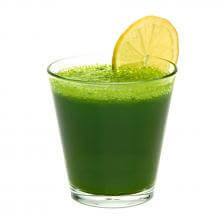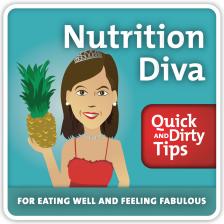Juicing: Healthy Habit or Blood Sugar Bomb?
Lots of people are juicing for health and it can be a good way to get more vegetable nutrition. But could it be doing a number on your blood sugar? Nutrition Diva weighs the pros and cons.

“My fiancee and I have started juicing for a healthier lifestyle. We make fresh juice using a variety of fruits and vegetables, including cucumbers, carrots, kale, spinach, celery, apples, and mangos and drink 16 ounces every 3-4 hours throughout the day, followed by a healthy dinner. But after reading your article about the potential for fresh juice to cause blood sugar spikes, I’m concerned that this might not be a healthy habit. What do you think?”
Sponsor: Netflix Instant Streaming. Watch thousands of TV episodes and movies on your PC, Mac, iPad, iPhone or Touch. Or on your TV through your XBox, PS3 or Wii. All streamed instantly by Netflix, saving you time, money and hassle. For a free 30-day trial, including the new Netflix Original Series House of Cards, go to Netflix.com/qdt.
I’ve noticed that when people start juicing, they tend to go big. Like Michael and his fiancee, they suddenly start drinking several quarts of fresh juice a day. They often consume nothing but juice for one or more meals. But the concern that Michael raises is a valid one.
As anyone who has ever made fresh juice knows, it takes several pounds of produce to produce 16 ounces of juice. And that’s part of what makes juicing seem like such a healthy habit. We all know that fruits and vegetables are good for us. And we constantly hear that people are falling short of the recommended intake, which is 5 servings of vegetables and 2-4 servings of fruit. Fresh juice seems like the perfect solution.
Theoretically, you’re getting the nutritional equivalent of at least a dozen servings of fruits and vegetable in every glass. The problem is that juicing also concentrates the natural sugars in fruits and vegetables while separating out all the fiber that would normally slow the absorption of sugars. If you drink the juice all by itself, those sugars will be quickly absorbed into your bloodstream.
See also: What Is High Glucose?
How Much Sugar Is in Fresh Juice?
Below, you’ll see a little table I put together of the 8 fruits and vegetables that Michael mentioned in his email, showing how much of each it takes to produce 16 ounces of juice and how much sugar that amount contains. As you can see from my chart, it takes between 2 and 3 pounds of produce to make 16 ounces of juice. The sugar content varies quite a bit. Fruit is the highest of course, followed by high sugar vegetables like beets and carrots. Green vegetables are the lowest. So, the sugar content of your mixed juice is going to depend on what combination of fruits and veggies you select. Also, keep in mind that not all of that sugar will end up in the juice. Some will be left behind, along with the fiber, in the pulp. For the sake of argument, let’s say that only 75% of the sugar makes it into the juice.
What Does Fresh Juice Do to Your Blood Sugar?
Let’s say that Michael’s fresh juice contains all of the fruits and vegetables he mentioned, in roughly equal amounts. Taking into account the fact that some of the sugar will be left behind in the pulp, we could guess that each 16-ounce serving would have about 38 grams of sugar, which is the amount in a 12-ounce can of Coca-Cola. Unfortunately, your glucose receptors and pancreas don’t really distinguish between the sugars in juice and the sugars in soda. My quick and dirty analysis suggests that drinking 16 ounces of fresh fruit and vegetable juice every 3-4 hours without any other food could definitely lead to some major blood sugar surges.
But hold on: Unlike the sugar in a Coke, the sugar in the juice is completely natural. It’s also accompanied by huge amounts of nutrients. After all, it takes at least a dozen servings of fruits and vegetables to produce a 16-ounce glass of juice! Surely all of that great nutrition would offset that pesky sugar issue!
Or would it..?
Many of the nutrients you’re getting from fruits and veggies are antioxidants. Antioxidants are great but there’s a limit to how much your body can actually utilize at one time. While there is a lot of evidence to support the idea that 5 servings of vegetables a day keeps you healthy, there’s little evidence to suggest that 50 servings a day keeps you any healthier. In fact, there’s some evidence to suggest that you can get too much of a good thing.
See also: Can You Get Too Many Antioxidants?
Where’s the Balance?
Fresh juice is nutritious, but it’s not balanced nutrition.
There’s another thing that concerns me about relying on juice as a major source of your calories, particularly on an ongoing basis. Fresh juice is nutritious but it’s not balanced nutrition. While it’s high in antioxidants and certain minerals (as well as sugar), it’s quite low in protein, fiber, and essential fatty acids – nutrients that your body also needs. If you are drinking nothing but juice for several meals a day, your diet could be low in other important nutrients.
How to Get the Most Out of Juice
If you really love the taste, or you’re convinced that fresh juice is making your life better, here are a few suggestions for maximizing your returns and minimizing any downside.
- Enjoy juice in moderation. There’s nothing wrong with enjoying a glass of fresh juice on a daily basis but 8-12 ounces a day is probably plenty. (I recommend limiting straight fruit juice to 4 ounces a day.)
- Enjoy juice with other healthy foods. Adding foods that contain fiber, healthy fats, and/or protein will not only round out the meal nutritionally, but will also slow the absorption of sugars from the juice. When it comes to digesting sugar, slower is generally better. Nuts or nut butter, whole grains, Greek yogurt, avocado, olive oil, fish, and/or whole fruits and vegetables would all be good complements to fresh juice.
- Enjoy juice after your work out. If you’re convinced that drinking the juice all by itself delivers additional benefits, consume it during or immediately after exercise, when it is less likely to cause a blood sugar spike.
- Try making “whole juice.” High-powered blenders can emulsify, or reduce, whole fruits and vegetables to a smoothie-like texture and retain the fiber. You can also add yogurt or flaxseeds for more balanced nutrition.

Thanks to Michael for his great question. If you have a topic you’d like me to address in a future podcast or newsletter, send an email to nutrition@quickanddirtytips.comcreate new email or post it on the Nutrition Diva Facebook page. I always love to hear from you!







